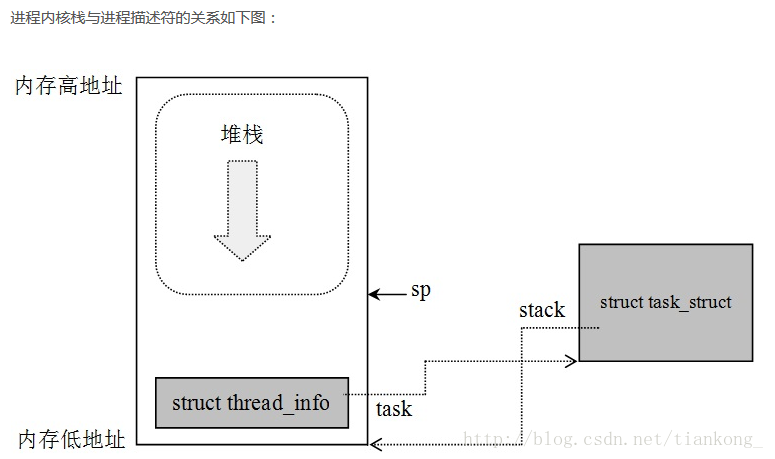内核栈与thread_info结构详解
本文转载自内核栈与thread_info结构详解
什么是进程的内核栈?
在内核态(比如应用进程执行系统调用)时,进程运行需要自己的堆栈信息(不是原用户空间中的栈),而是使用内核空间中的栈,这个栈就是进程的内核栈
进程的内核栈在计算机中是如何描述的?
linux中进程使用task_struct数据结构描述,其中有一个stack指针
struct task_struct
{
// ...
void *stack; // 指向内核栈的指针
// ...
};
task_struct数据结构中的stack成员指向thread_union结构(Linux内核通过thread_union联合体来表示进程的内核栈)
union thread_union {
struct thread_info thread_info;
unsigned long stack[THREAD_SIZE/sizeof(long)];
};
struct thread_info是记录部分进程信息的结构体,其中包括了进程上下文信息:
struct thread_info {
struct pcb_struct pcb; /* palcode state */
struct task_struct *task; /* main task structure */ /*这里很重要,task指针指向的是所创建的进程的struct task_struct
unsigned int flags; /* low level flags */
unsigned int ieee_state; /* see fpu.h */
struct exec_domain *exec_domain; /* execution domain */ /*表了当前进程是属于哪一种规范的可执行程序,
//不同的系统产生的可执行文件的差异存放在变量exec_domain中
mm_segment_t addr_limit; /* thread address space */
unsigned cpu; /* current CPU */
int preempt_count; /* 0 => preemptable, <0 => BUG */
int bpt_nsaved;
unsigned long bpt_addr[2]; /* breakpoint handling */
unsigned int bpt_insn[2];
struct restart_block restart_block;
};

从用户态刚切换到内核态以后,进程的内核栈总是空的。因此,esp寄存器指向这个栈的顶端,一旦数据写入堆栈,esp的值就递减
thread_info的作用是?
这个结构体保存了进程描述符中中频繁访问和需要快速访问的字段,内核依赖于该数据结构来获得当前进程的描述符(为了获取当前CPU上运行进程的task_struct结构,内核提供了current宏。
#define get_current() (current_thread_info()->task)
#define current get_current()
内核还需要存储每个进程的PCB信息, linux内核是支持不同体系的的, 但是不同的体系结构可能进程需要存储的信息不尽相同,
这就需要我们实现一种通用的方式, 我们将体系结构相关的部分和无关的部门进行分离,用一种通用的方式来描述进程, 这就是struct task_struct, 而thread_info
就保存了特定体系结构的汇编代码段需要访问的那部分进程的数据,我们在thread_info中嵌入指向task_struct的指针, 则我们可以很方便的通过thread_info来查找task_struct
内核栈的大小?
进程通过alloc_thread_info函数分配它的内核栈,通过free_thread_info函数释放所分配的内核栈,查看源码
alloc_thread_info函数通过调用__get_free_pages函数分配2个页的内存(8192字节)



【推荐】国内首个AI IDE,深度理解中文开发场景,立即下载体验Trae
【推荐】编程新体验,更懂你的AI,立即体验豆包MarsCode编程助手
【推荐】抖音旗下AI助手豆包,你的智能百科全书,全免费不限次数
【推荐】轻量又高性能的 SSH 工具 IShell:AI 加持,快人一步
· 10年+ .NET Coder 心语,封装的思维:从隐藏、稳定开始理解其本质意义
· .NET Core 中如何实现缓存的预热?
· 从 HTTP 原因短语缺失研究 HTTP/2 和 HTTP/3 的设计差异
· AI与.NET技术实操系列:向量存储与相似性搜索在 .NET 中的实现
· 基于Microsoft.Extensions.AI核心库实现RAG应用
· TypeScript + Deepseek 打造卜卦网站:技术与玄学的结合
· 阿里巴巴 QwQ-32B真的超越了 DeepSeek R-1吗?
· 【译】Visual Studio 中新的强大生产力特性
· 10年+ .NET Coder 心语 ── 封装的思维:从隐藏、稳定开始理解其本质意义
· 【设计模式】告别冗长if-else语句:使用策略模式优化代码结构